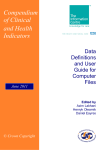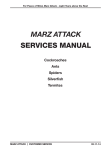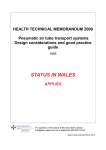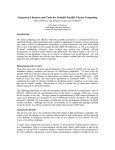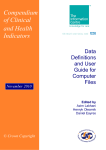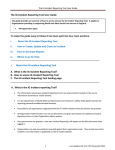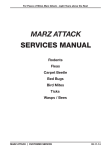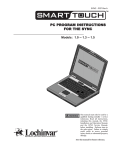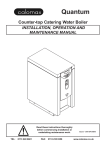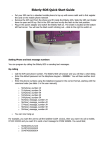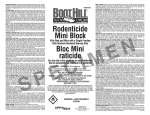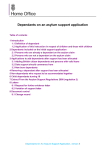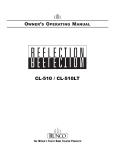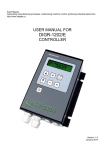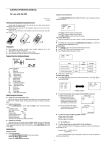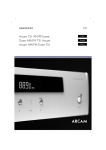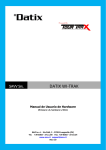Download HTM 66 covers - Health in Wales
Transcript
HEALTH TECHNICAL MEMORANDUM 66 Building Component Series Cubicle curtain track 2005 STATUS IN WALES APPLIES This document replaced HTM 66 Building Component Series Cubicle curtain track 1989 For queries on the status of this document contact [email protected] or telephone 029 2031 5512 Status Note amended March 2013 HTM 66 – Cubicle curtain track (BUILDING COMPONENTS SERIES) HTM 66 Cubicle curtain track HTM BUILDING COMPONENTS SERIES ISBN 0-11-322691-8 www.tso.co.uk 9 780113 226917 HTM 66 Cubicle curtain track HTM BUILDING COMPONENTS SERIES London: The Stationery Office Published by TSO (The Stationery Office) and available from: Online www.tso.co.uk/bookshop Mail, Telephone, Fax & E-mail TSO PO Box 29, Norwich NR3 1GN Telephone orders/General enquiries 0870 600 5522 Fax orders 0870 600 5533 E-mail [email protected] TSO Shops 123 Kingsway, London WC2B 6PQ 020 7242 6393 Fax 020 7242 6394 68–69 Bull Street, Birmingham B4 6AD 0121 236 9696 Fax 0121 236 9699 9–21 Princess Street, Manchester M60 8AS 0161 834 7201 Fax 0161 833 0634 16 Arthur Street, Belfast BT1 4GD 028 9023 8451 Fax 028 9023 5401 18–19 High Street, Cardiff CF10 1PT 029 2039 5548 Fax 029 2038 4347 71 Lothian Road, Edinburgh EH3 9AZ 0870 606 5566 Fax 0870 606 5588 TSO Accredited Agents (see Yellow Pages) and through good booksellers © Crown copyright 2005 Published with the permission of NHS Estates, an Executive Agency of the Department of Health, on behalf of the Controller of Her Majesty’s Stationery Office. This document/publication is not covered by the HMSO Click-Use Licences for core or added-value material. If you wish to re-use this material, please send your application to: Copyright applications NHS Estates Windsor House Cornwall Road Harrogate HG1 2PW ISBN 0-11-322691-8 First published 1989; second edition 2005 Printed in the United Kingdom for The Stationery Office The paper used in the printing of this document (Revive Silk) is 75% made from 100% de-inked postconsumer waste, the remaining 25% being mill broke and virgin fibres. Recycled papers used in its production are a combination of Totally Chlorine Free (TCF) and Elemental Chlorine Free (ECF). It is recyclable and biodegradable and is an NAPM and Eugropa approved recycled grade. Contents 1 Introduction page 2 Background Scope and status Relationship to other data Terminology 2 User requirements page 4 Constituent parts Constituent materials Exposed surfaces Fire propagation Strength Electrostatic charges Quietness and smoothness in operation Curtain hanging and changing Resistance to mechanical wear Biological control 3 Design guidance page 5 Track height Cubicle layouts Track suspension Anti ligature Curtains and curtain changing Maintenance manual References page 9 Acts and regulations NHS Estates resources Department of Health publications British Standards About our guidance and publications page 10 1 HTM 66 – CUBICLE CURTAIN TRACK 1 Introduction BACKGROUND 1.1 This is one of a series of Health Technical Memoranda which provide specifications and design guidance on building components for health buildings. 1.2 The numbers and titles of the HTMs in the series are: 54 User manual 55 Windows 56 Partitions 57 Internal glazing 58 Internal doorsets 59 Ironmongery 60 Ceilings 61 Flooring Management (CDM) Regulations 1994 (as amended 2000) to ensure safe construction. RELATIONSHIP TO OTHER DATA 1.5 The main sources of data used in the preparation of this HTM are listed in the References section. 1.6 This HTM was prepared for publication in January 2005. After this date, readers should ensure that they use the latest or new edition of all building legislation, British Standards etc, which may post-date the publication of this document. 1.7 First preference should be given to products and services from sources which have been registered under ISO 9000 quality assurance system procedures or other certification schemes. Suppliers offering products other than to British Standards should provide evidence to show that their products are at least equal to such Standards. 62 Demountable storage system 1.8 Any enquiries regarding the technical content of this HTM should be e-mailed to [email protected]. 63 Fitted storage system TERMINOLOGY 64 Sanitary assemblies 1.9 In this HTM the following definitions apply: 66 Cubicle curtain track • Cubicle curtain track system – a component assembly to support curtains forming cubicles. 67 Laboratory fitting out systems 68 Duct and panel assemblies 69 Protection 71 Materials management modular storage. • Track – the horizontal member which supports the runners and the curtains. • Suspended track – track fixed at a level significantly below the ceiling soffit. SCOPE AND STATUS • Ceiling fixed track – track fixed directly to the ceiling soffit. 1.3 This HTM offers guidance on the technical design and output specifications of curtain cubicle track in health buildings. • Track height – dimension from finished floor level to underside of track. 1.4 Its content does not diminish either the manufacturer’s responsibility for fitness for purpose of products or the design team’s responsibility for selection and application of products to meet project requirements. Design teams are also reminded of their obligations under the Construction, Design and 2 • Parking of curtains – the drawing back and bunching of curtains to predetermined positions when not in use. • Loading device – a device to facilitate the removal and replacement of curtains. 1 INTRODUCTION • Low weight release system (anti-ligature) – designed to reduce the possibility of patient self-harm, this is a system that will securely retain the load it is designed for. When an abnormal load is applied, it will release the load. • Anti-deflection device – mechanism to reduce or eliminate deflection on application of load at the centre of the track. 3 HTM 66 – CUBICLE CURTAIN TRACK 2 User requirements CONSTITUENT PARTS 2.1 Each cubicle curtain track system should comprise: • track; collapsible subsystem (but see also paragraphs 3.17–3.18 for rails used in mental health settings). The weakest components in the system should be the gliders or runners. • wall fixing devices; ELECTROSTATIC CHARGES • direct-to-ceiling fixings – vertical hangers – V-hangers; 2.6 No system should, to any appreciable extent, develop or shed electrostatic charges. • bay connectors; QUIETNESS AND SMOOTHNESS IN OPERATION • stop ends; 2.7 No quantifiable criteria are available for quietness and smoothness in operation, but systems should be selected with these two important requirements in mind. • curtain loading device; • gliders or runners; • hooks or buttons; • low weight release systems (anti-ligature). CONSTITUENT MATERIALS 2.2 All parts must be of corrosion-resistant materials. Choice of materials should be such that they do not suffer dissimilar metal corrosion. No constituent part should contain material: • known or reasonably believed to constitute a health hazard under normal conditions of use; • which will give off toxic products in the event of a fire. EXPOSED SURFACES 2.8 Particular consideration should be given to the operation of gliders or runners at approximately 100 mm centres around bends of minimum radius. 2.9 During installation, care must be taken to avoid stepped joints where it is necessary to join track. CURTAIN HANGING AND CHANGING 2.10 Gliders or runners should be designed to enable attachment of curtains by hooks or buttons. 2.11 Each system should include a device which will facilitate the loading or unloading of curtains from the track (see paragraphs 3.19–3.34). RESISTANCE TO MECHANICAL WEAR 2.3 All surface finishes should be capable of withstanding the range of temperature and humidity conditions encountered in health buildings. 2.12 Gliders and runners and track-wearing surfaces should be capable of withstanding at least 20,000 cycles of curtain movement without appreciable loss of quietness or smoothness in operation, or visible wear. FIRE PROPAGATION BIOLOGICAL CONTROL 2.4 All structural parts of a system should be noncombustible as defined in BS 476-4:1970, but combustible materials may be employed for small nonstructural parts. 2.13 No system should contain material capable of supporting the growth of bacteria, fungi etc or encouraging the harbourage of insects or mites. STRENGTH 2.5 Track suspension (braced or unbraced) should have a breaking strength of not less than 180 kg between upper and lower fixing points at any location within the 4 3 Design guidance TRACK HEIGHT 3.1 There are a number of factors to be considered in determining curtain track height and the related form of suspension or direct fixing to the ceiling. 3.2 One of the most important considerations is the effect of curtains, whether drawn or parked, on natural and artificial lighting. 3.3 Design teams should also consider the appearance of track and curtain configurations within and around the cubicles. Track height may need to coordinate with window head height or glazed screen depending on configuration. 3.4 For suspended track installations, track height will normally be 2100 mm. Figure 1 Single bay cubicles 3.5 Ceiling-fixed track applications are normally limited to ceiling heights of up to 2700 mm. In such instances, the 600 mm difference comprises a lightweight fabric net which permits the passage of light and air movement. Note: Where an overhead tracking system has been installed to transfer or move patients, the height of the curtain may need to be altered to allow free movement of the equipment. CUBICLE LAYOUTS 3.6 Examples of single- and multiple-bay cubicle layouts and their relationship to walls or partitions are given in Figures 1 and 2. Space within and around cubicles should take account of the dimensional guidance Figure 2 Multiple bay cubicles One sided One sided Two sided Two sided Three sided 5 HTM 66 – CUBICLE CURTAIN TRACK contained in HBN 4 – ‘In-patient accommodation – options for choice’ and HBN 40 – ‘Common activity spaces’ (both documents are now under revision). TRACK SUSPENSION 3.7 In both suspended and ceiling-fixed track systems, the spacing and location of fixing points should be strictly in accordance with the manufacturers’ recommendations. 3.11 As shown in Figure 5, where the arrangement of windows, engineering services and bedhead units permits, curtains may be parked on an extension of the track fixed parallel to a wall and supported by a wall bracket. This support is as effective as the normal wall fixing which is used where track meets wall at 90°. Figure 5 W W W 3.8 Suspended track must be restrained to prevent horizontal movement by: • direct fixing of track to flank walls or partitions; • tie-bars; • V-hangers fixed to the ceiling; • any combination of these as appropriate to the layout. 3.9 Some examples are given in Figures 3–5. In Figure 3, wall fixings at one end of front rail (with tie-bar where necessary) provide adequate lateral support for up to eight cubicles. Beyond that, the track manufacturer should be consulted. Figure 3 3.12 Note that V-hangers have a very limited application. A tie-bar with wall fixing provides much more effective lateral restraint. 3.13 Tie-bars comprise lengths of track which are not fitted with gliders or runners; this ensures consistency of appearance and standardisation of fittings. 3.14 Ceiling-fixed track needs no restraint to prevent horizontal movement. 3.15 Hangers supporting track are generally of rod construction. However, wire hangers are preferred when the hanger is longer than 1000 mm or when raking hangers must be used because a ceiling fixing is not practical (for example, a weak membrane in an existing ceiling). 3.16 Obtain advice from the manufacturer whenever unusual project conditions apply. TB LOW WEIGHT RELEASE SYSTEMS 3.17 For some years it has been recognised that a major means of suicide among in-patients in mental health units is using curtain or shower rails as a ligature point. In 2000, the Department of Health report ‘An organisation with a memory’ instructed mental health trusts to take steps to remove all non-collapsible bed and shower curtain rails in mental health in-patient units. 3.10 In Figure 4, V-hangers provide lateral restraint on inner tracks of up to three cubicles when no wall fixing on front rail can be provided. Beyond three cubicles, the track manufacturer should be consulted. 3.18 In summary, the following action should be taken: • Identify and remove all non-collapsible bed, cubicle and shower curtain rails and window curtain rails in mental health in-patient settings. Figure 4 • Replace with collapsible-type bed and shower curtains. • System manufacturers should provide installation drawings showing positions of hangers. • Ensure any new system does not introduce new risk. 6 3 DESIGN GUIDANCE • The tracking must be designed to collapse when non-vertical loads are applied to it. The system must incorporate anti-deflection devices as required to ensure that only full collapses, not partial, occur. 3.28 For example, a bed space 2900 mm deep and 2500 mm long, assuming curtains for one side and the end are to be parked, will require 810 mm of track for parking. • Flexible dust covers should be cut into maximum 150 mm lengths. Alternatively, a solid cover can be used. 3.29 Part of the curtain can be parked behind the bedhead, but it is unlikely that projection of the curtain from the wall can be eliminated entirely. If the trust has a policy which includes tightly bunching the curtains, the provision of extra track solely for curtain parking can be reduced. • Once installed, ensure regular maintenance checks and load tests are carried out according to manufacturers’ instructions. Curtain changing See also NHS Estates alert notices NHSE (2004) 05; NHSE (2004) 08; NHSE (2004) 10; and SN (2002) 01. CURTAINS AND CURTAIN CHANGING 3.19 Commissioning and design teams must cooperate when selecting curtains, particularly when deciding on the thickness, colour and fullness of curtains and the adequacy of suspension tape. Earlier design decisions regarding bunching and parking of curtains and the transmission of light and ventilation should be passed on to the commissioning team. 3.20 For ceiling-fixed tracks, the transmission of light and ventilation is of particular importance and will involve scalloping or netting (which may be difficult to clean) from 2100 mm to ceiling level. 3.21 All curtains are treated with a fire-retardant tested in accordance with BS 5438-1:1976. 3.22 Printed curtains are 1200 mm wide and 2000 mm high; colour woven curtains are 1830 mm wide and 2000 mm high. 3.23 The amount of fullness can vary from 5 to 25% depending on hospital policy. Curtain parking 3.24 A key consideration in detailing layouts is the parked position of cubicle curtains, either along a wall or at right-angles to it. Curtains parked along a wall allow maximum observation, but are less easy to draw, and call for careful detailing to avoid obstruction of adjacent engineering service outlets. 3.30 Domestic services staff are usually responsible for changing curtains. Speed and efficiency of the procedure are of great importance to the smooth running of the department, which should minimise: • loss of cubicle function; • hindrance to other user activities by restricting or blocking circulation spaces; • disturbance of patients; • operator fatigue and the associated risk of accidents when working at or near ceiling height; and • risk of cross-infection due to movement of soiled curtains. 3.31 Curtain-loading devices reduce these problems by enabling staff to change curtains more quickly and transferring the hooking and unhooking stages to normal working height. One device per floor is usually adequate. They: • allow an untrained operative to load a curtain complete with gliders or runners; • are for use on suspended or (with minor adaptation) on ceiling-fixed track; • give full control of feed-on of gliders or runners. 3.32 Soiled curtains are usually unloaded straight into a container on the floor, the gliders or runners being run off the track when an end-stop is removed to fit the loading device. 3.25 Curtains parked at right-angles to a wall reduce observation but, by the same token, increase privacy. They are easier to draw and less likely to obstruct adjacent engineering terminals. 3.33 Curtains are changed at the end of the cubicle furthest from the patient’s head, and the fitting and removal of gliders or runners to the curtains takes place entirely outside the patients’ area. 3.26 Parked curtains will obviously take up some of the working space of bed areas, and the parking space will vary depending on the fullness of the material. 3.34 The accuracy and frequency with which hooks or buttons are spaced along the operative width of the curtain is a key factor in ensuring that the curtain will draw easily around track bends. This will be achieved if the hooks or buttons are fitted to the curtain before delivery to the cubicle. The use of curtains with 3.27 As a general rule, track required to park the curtains will be about 15% of track length when cotton fabric is used. 7 HTM 66 – CUBICLE CURTAIN TRACK predetermined hook or button positions should be considered. 3.38 A new “model cleaning contract” for hospitals has been developed. This has three key elements: MAINTENANCE MANUAL • the National Standards of Cleanliness (introduces measures for HCAI cleaning and disinfection); General 3.35 An operation and maintenance manual should be compiled by the project architect and should be handed to the maintenance staff immediately following the practical completion of the contract. 3.36 The manufacturer’s recommendations in respect of periodic inspection and maintenance should be followed to ensure that acceptable levels of performance are maintained (see also final bullet point in paragraph 3.18). Hygiene and cleaning 3.37 The design, materials and workmanship of a system should be such that when installed it will not generate dust or dirt. 8 • the NHS Cleaning Manual (sets out best practice methods for cleaning); • cleaning frequencies (these should be determined to address the element of risk identified in accordance with the National Standards of Cleanliness and taking into account any further advice and guidance in the model cleaning contract and the NHS Cleaning Manual). 3.39 The construction should be capable of withstanding the cleaning regimes given in the above guidance. References ACTS AND REGULATIONS (The) Building Regulations 2000 (SI 2000: 2531). The Stationery Office, 2000. http://www.hmso.gov.uk/si/si2000/20002531.htm (The) Construction (Design and Management) [CDM] Regulations 1994, SI 1994 No 3140. HMSO, 1995. http://www.hmso.gov.uk/si/si1994/Uksi_19943140_en_ 1.htm (The) Construction (Design and Management) (Amendment) Regulations 2000, SI 2000 No 2380. The Stationery Office. http://www.legislation.hmso.gov.uk/si/si2000/20002380. htm NHS ESTATES RESOURCES HBN 4 – ‘In-patient accommodation – options for choice’. The Stationery Office, 1997. HBN 40: Volumes 1–4 – ‘Common activity spaces’. The Stationery Office, 1995. NHS Estates Alert Notice NHSE (2004) 08. Cubicle tracking. http://www.nhsestates.gov.uk/healthcare_eng_science/ index.asp NHS Estates Alert Notice NHSE (2004) 10. Bed cubicle rails, shower curtain rails and curtain rails in psychiatric in-patient settings.. http://www.nhsestates.gov.uk/healthcare_eng_science/ index.asp NHS Estates Safety Notice SN (2001) 01. Cubicle rail suspension system with load release support systems. http://www.nhsestates.gov.uk/healthcare_eng_science/ index.asp DEPARTMENT OF HEALTH PUBLICATIONS (An) Organisation with a memory. Report of an expert group on learning from adverse events in the NHS. Chaired by the Chief Medical Officer. The Stationery Office, 2000. http://www.dh.gov.uk/assetRoot/04/06/50/86/ 04065086.pdf HTM 55 – ‘Windows’. The Stationery Office, 2005. BRITISH STANDARDS HTM 56 – ‘Partitions’. The Stationery Office, 2005. BS 476-4:1970 Fire tests on building materials and structures. Non-combustibility test for materials. British Standards Institution, 1970. HTM 60 – ‘Ceilings’. The Stationery Office, 2005. National Standards of Cleanliness http://patientexperience.nhsestates.gov.uk/clean_ hospitals/ch_content/home/home.asp NHS Cleaning Manual http://patientexperience.nhsestates.gov.uk/clean_ hospitals/ch_content/home/home.asp BS 4901:1976 Specification for plastics colours for building purposes. British Standards Institution, 1976. BS 5438-1:1976 Methods of test for flammability of vertically oriented textile fabrics and fabric assemblies subjected to a small igniting flame. British Standards Institution, 1976. NHS Estates Alert Notice NHSE (2004) 05. Suspended ceilings. http://www.nhsestates.gov.uk/healthcare_eng_science/ index.asp 9 HTM 66 – CUBICLE CURTAIN TRACK About our guidance and publications The Agency has a dynamic fund of knowledge which it has acquired over 40 years of working in the field. Our unique access to estates and facilities data, policy and information is shared in guidance delivered in four principal areas: Procurement & Property Design & Building Examples of titles published under this heading are: These documents look at the issues involved in planning, briefing and designing facilities that reflect the latest developments and policy around service delivery. They provide current thinking on the best use of space, design and functionality for specific clinical services or non-clinical activity areas. They may contain schedules of accommodation. Guidance published under the headings Health Building Notes (HBNs) and Design Guides are found in this category. Estatecode How to cost a hospital Developing an estate strategy Examples include: HBN 22, Accident and emergency facilities for adults and children HBN 57, Facilities for critical care HFN 30, Infection control in the built environment: design and planning Engineering & Operational (including Facilities Management, Fire, Health & Safety and Environment) These documents provide guidance on the design, installation and running of specialised building service systems and also policy guidance and instruction on Fire, Health & Safety and Environment issues. Health Technical Memoranda (HTMs) and Health Guidance Notes (HGNs) are included in this category. Examples include: HTM 2007, Electrical services supply and distribution HTM 2021, Electrical safety code for high voltage systems HTM 2022 Supplement 1 Sustainable development in the NHS These are documents which deal with areas of broad strategic concern and planning issues, including capital and procurement. NHS Estates Policy Initiatives In response to some of the key tasks of the Modernisation Agenda, NHS Estates has implemented, project-managed and monitored several programmes for reform to improve the overall patient experience. These publications document the project outcomes and share best practice and data with the field. Examples include: Modernising A & E Environments Improving the Patient Experience – Friendly healthcare environments for children and young people Improving the Patient Experience – Welcoming entrances and reception areas National standards of cleanliness for the NHS NHS Menu and Recipe Books The majority of publications are available in hard copy from: The Stationery Office Ltd PO Box 29, Norwich NR3 1GN Telephone orders/General enquiries 0870 600 5522 Fax orders 0870 600 5533 E-mail [email protected] http://www.tso.co.uk/bookshop Publication lists and selected downloadable publications can be found on our website: http://www.nhsestates.gov.uk For further information please contact our Information Centre: e-mail: [email protected] tel: 0113 254 7070 10 Core guidance feedback Please complete this feedback form and return it to NHS Estates. The information provided will help in the assessment of the value of this document and in the planning of future Agency guidance. Title: ..................................................................... Series and series number if applicable (eg Health Building Note 57): ..................................................................... 1. How useful is this document to you/your organisation? 1 2 3 4 5 Not at all useful 6 Very useful 2. Are you aware of other sources of the information contained in this document? Yes No If Yes, please state below: ..................................................................... 3. Did you feel the content was: Too prescriptive? Too ambiguous? About right? 4. Was the amount of technical content in the document: Too high? Too low? About right? 5. How would you rate the length of the document? Too long Too short About right Please return this form to: Knowledge Management NHS Estates Windsor House Cornwall Road Harrogate HG1 2PW Thank you


















